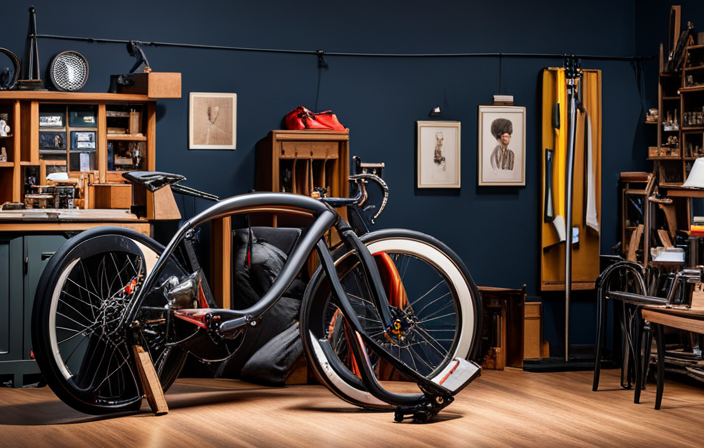Are you tired of searching for a convenient way to charge your electric bike? Look no further, because I have the perfect solution for you!
Imagine a world where you can effortlessly power up your electric bike using nothing but the sun’s energy. With the help of a solar panel, this dream can become a reality.
In this article, I will guide you through the process of charging your electric bike with a solar panel, giving you the freedom to ride with ease and without worrying about running out of battery power.
Key Takeaways
- Solar charge controller is essential for charging electric bikes with solar panels.
- Regular maintenance and cleaning of solar panels are necessary for efficient charging.
- Having a backup charging method is important for uninterrupted charging.
- Optimizing solar panel efficiency can maximize the charging capacity for electric bikes.
Understand the Basics of Solar Power
You’ll need to understand the basics of solar power to effectively charge your electric bike with a solar panel. Solar power offers numerous benefits, including being a clean and renewable energy source. It reduces carbon emissions and helps combat climate change.
To harness solar power, you’ll need to have a solar power installation. This involves installing solar panels on your property that can convert sunlight into electricity. These panels are made up of photovoltaic cells that absorb sunlight and convert it into usable energy. It’s important to ensure that your solar power installation is done correctly to maximize efficiency.
Once you have a solar power system in place, you can then charge your electric bike using the solar energy it generates. To do this, you’ll need to choose the right solar panel that is compatible with your electric bike.
Choose the Right Solar Panel
Make sure to select the appropriate solar panel for your needs when choosing the right solar panel for your electric bike. Solar panel efficiency is an important factor to consider. To help you make an informed decision, here is a comparison of solar panel efficiency:
| Solar Panel Type | Efficiency (%) | Cost ($) | Size (inches) |
|---|---|---|---|
| Monocrystalline | 22-24 | High | Small |
| Polycrystalline | 15-17 | Medium | Medium |
| Thin-Film | 10-12 | Low | Large |
Monocrystalline panels offer the highest efficiency, making them a great choice if you have limited space. Polycrystalline panels are a more affordable option with slightly lower efficiency. Thin-film panels are the least efficient but are the most budget-friendly and suitable for larger spaces.
Choosing the right solar panel is crucial for effectively charging your electric bike. Once you have selected the right panel, you can move on to determining your energy needs.
Determine Your Energy Needs
To accurately assess the amount of energy required, it’s important to determine your specific energy needs.
To calculate energy requirements for charging an electric bike with a solar panel, consider factors such as the bike’s battery capacity, the average distance you plan to ride, and the frequency of charging.
Start by determining the battery capacity of your electric bike, which is usually measured in watt-hours (Wh). Next, estimate the average distance you ride per day and the number of days you plan to charge the bike using solar power. Multiply the average distance by the number of days to get the total energy needed.
Additionally, consider any other electrical devices you may want to charge simultaneously. By accurately calculating your energy requirements, you can ensure that your solar panel setup meets your charging needs.
Now, let’s find a suitable location for your solar panel setup.
Find a Suitable Location for Your Solar Panel
Finding a suitable location for your solar panel setup is crucial for maximizing energy efficiency. When it comes to solar panel placement, finding the right angle is key.
Ideally, your solar panels should be facing directly south to capture the most sunlight throughout the day. This ensures that they receive optimal exposure and generate maximum electricity.
Additionally, you should consider the angle of inclination for your solar panels. The angle should be adjusted according to your latitude to maximize energy production. Placing the solar panels at the correct angle will allow them to absorb more sunlight and generate more power for charging your electric bike.
Once you have determined the ideal location and angle for your solar panels, you can proceed to set up your solar panel system, which will be discussed in the subsequent section.
Set Up Your Solar Panel System
Once you’ve found the perfect location and angle for your solar panels, it’s time to get your solar panel system up and running.
To maximize efficiency, start by securely mounting the solar panels on a stable structure or roof. Ensure that the panels are facing the sun directly and at the optimal angle.
Connect the panels to an inverter, which converts the DC power generated by the panels into AC power that can be used to charge your electric bike.
Install a charge controller to regulate the flow of electricity and prevent overcharging.
Finally, connect the inverter and charge controller to your electric bike’s battery using appropriate cables.
It’s important to regularly monitor your solar panel system’s performance and troubleshoot any issues that may arise.
With your solar panel system set up, you’re now ready to connect it to your electric bike and start charging.
Connect Your Solar Panel to Your Electric Bike
Now that you have your solar panel system set up, it’s time to connect it to your electric bike.
To ensure optimal solar panel efficiency, make sure that your solar panel is positioned in direct sunlight and is angled correctly.
Connect the output of the solar panel to a charge controller, which will regulate the voltage and current going into your electric bike’s battery. The charge controller also acts as a backup charging system, allowing you to charge your electric bike using grid power if there is limited sunlight.
Once the charge controller is connected, attach the output cables to the battery terminals of your electric bike. This will enable the solar panel to charge your electric bike’s battery.
Now, let’s move on to the next section where we will discuss how to monitor the charging process.
Monitor the Charging Process
To effectively monitor the process, I use a digital monitor to track the charging progress of my electric bike’s battery. This allows me to remotely monitor the charging efficiency and ensure that my bike’s battery is being charged effectively.
The digital monitor provides real-time information on the charging voltage, current, and charging time, allowing me to keep a close eye on the charging process. This is especially important when using solar panels, as it helps me optimize the charging process and take full advantage of the available daylight hours.
By monitoring the charging process, I can ensure that my electric bike’s battery is efficiently charged, maximizing its range and overall performance.
Take Advantage of Daylight Hours
Make sure you make the most of daylight hours to optimize the performance of your electric bike’s battery. One of the key ways to do this is by maximizing the efficiency of your solar panel placement. By strategically positioning your solar panels to capture the most sunlight throughout the day, you can ensure that your electric bike’s battery is being charged as efficiently as possible. To help you visualize this, consider the following table:
| Time of Day | Sunlight Intensity | Solar Panel Angle |
|---|---|---|
| 8:00 AM | High | 45° |
| 12:00 PM | Very High | 90° |
| 4:00 PM | High | 45° |
| 6:00 PM | Medium | 30° |
| 8:00 PM | Low | 15° |
As you can see, the sunlight intensity and the angle of the solar panel change throughout the day. By adjusting the angle of the solar panel accordingly, you can maximize the amount of sunlight it captures. This will help ensure that your electric bike’s battery is charged efficiently. Speaking of efficiency, the next step is to use a solar charge controller to regulate the charging process.
Use a Solar Charge Controller
Using a solar charge controller helps regulate the charging process efficiently. It is a device that prevents overcharging and over-discharging of batteries connected to the solar panel. Acting as a middleman between the solar panel and the battery, it ensures that the battery receives the optimal amount of charge.
One of the benefits of using a solar charge controller is that it protects the battery from damage, prolonging its lifespan. Additionally, it maximizes the energy harvested from the solar panel by tracking the maximum power point of the panel and adjusting the charge accordingly.
Installing a solar charge controller is relatively simple and involves connecting it between the solar panel and the battery. By using a solar charge controller, you can ensure that your electric bike is charged effectively and efficiently.
Now, let’s move on to how to maintain and clean your solar panel.
Maintain and Clean Your Solar Panel
Regular maintenance and cleaning are necessary to ensure the optimal performance of your solar panel. To keep your solar panel functioning efficiently, here are some essential cleaning techniques and common maintenance issues to address:
-
Regularly inspect the panel for any signs of damage, such as cracks or loose connections. Ensure all connections are secure and tight.
-
Clean the panel’s surface with a soft cloth or sponge using a mixture of mild soap and water. Avoid using abrasive materials or harsh chemicals that may damage the panel.
-
Remove any debris, leaves, or bird droppings that may accumulate on the panel. These can block sunlight and reduce its efficiency.
By following these cleaning techniques and addressing common maintenance issues, you can maximize the energy output of your solar panel.
However, it is also crucial to consider a backup charging method to ensure continuous power supply, especially during periods of low sunlight.
Consider a Backup Charging Method
It’s important to have a backup method for powering your devices in case of low sunlight or other issues. While solar panels are a great way to charge your electric bike, they rely on sunlight to generate electricity. However, there may be times when you don’t have access to enough sunlight to fully charge your bike.
In these situations, it’s crucial to consider alternative charging options and backup power sources.
One option is to have a portable power bank or generator that can be charged using solar energy or other methods, such as plugging it into a wall outlet. This backup power source can be used to charge your electric bike when sunlight is limited or unavailable.
Additionally, some electric bikes may also have the ability to be charged using a standard electrical outlet, which can serve as another backup charging method.
By having alternative charging options and a backup power source, you can ensure that your electric bike is always ready to ride, regardless of the sunlight conditions.
Now, let’s explore how to optimize your solar panel efficiency for maximum charging capability.
Optimize Your Solar Panel Efficiency
Now that we have considered a backup charging method, let’s focus on optimizing the efficiency of your solar panel to increase its output. Improving the efficiency of your solar panel is essential to ensure that you generate enough power to charge your electric bike effectively.
Here are some ways to achieve this:
- Position your solar panel correctly to maximize sunlight exposure.
- Clean your solar panel regularly to remove dirt and debris that can block sunlight.
- Use high-quality solar panels with a high conversion rate.
- Consider using solar tracking systems to follow the sun’s movement throughout the day.
- Install an MPPT charge controller to optimize the power transfer from the solar panel to the battery.
By implementing these strategies, you can significantly improve the efficiency and output of your solar panel, ensuring a reliable power source for charging your electric bike.
Now, let’s calculate your savings and environmental impact.
Calculate Your Savings and Environmental Impact
To calculate your savings and environmental impact, you can assess the cost reduction and ecological benefits achieved through optimizing the efficiency of your solar panel. By maximizing the output of your solar panel, you can generate more electricity, resulting in lower energy bills and increased savings over time. The amount of money you save will depend on factors such as the size of your solar panel system, the amount of sunlight it receives, and your local energy rates.
Additionally, by using solar energy to charge your electric bike, you can significantly reduce your carbon footprint and contribute to a cleaner environment. The environmental impact is measured by the amount of greenhouse gas emissions avoided through the use of solar energy instead of traditional grid electricity.
By calculating your savings and environmental impact, you can make informed decisions about adopting solar energy and contribute to a more sustainable future.
Now, let’s explore additional solar-powered accessories.
Explore Additional Solar-Powered Accessories
You can explore various accessories that are powered by the sun. Solar-powered camping gear and solar-powered phone chargers are just a couple of examples. These accessories provide a convenient and sustainable way to power your devices while on the go.
To give you an idea of the range of solar-powered accessories available, here is a table showcasing some popular options:
| Accessory | Description |
|---|---|
| Solar-powered camping gear | Includes solar tents, solar lanterns, solar backpacks, and more. These accessories are perfect for outdoor enthusiasts who want to minimize their environmental impact. |
| Solar-powered phone chargers | These compact devices allow you to charge your phone using solar energy. They are lightweight and portable, making them ideal for travel and outdoor activities. |
By investing in these solar-powered accessories, you can enjoy the benefits of renewable energy while exploring the great outdoors. Embrace the benefits of solar-powered transportation, which we will discuss in the next section.
Embrace the Benefits of Solar-Powered Transportation
Embracing solar-powered transportation offers numerous benefits for individuals and the environment. Solar powered vehicles are an excellent solution for reducing carbon emissions and minimizing our reliance on fossil fuels. Here are three key advantages of solar-powered transportation:
-
Environmental Sustainability: Solar-powered vehicles produce zero emissions, helping to combat climate change and air pollution. By utilizing the sun’s energy, these vehicles do not contribute to greenhouse gas emissions, making them an eco-friendly transportation option.
-
Cost Savings: Solar-powered transportation can lead to significant cost savings in the long run. With the use of solar panels, you can generate your own electricity to power your vehicle, reducing or eliminating the need for traditional fuel sources. This can result in lower energy bills and decreased reliance on fluctuating fuel prices.
-
Energy Independence: By embracing solar-powered transportation, you become less dependent on external energy sources. The sun’s energy is abundant and renewable, providing a reliable and sustainable power source. This independence helps to reduce the vulnerability of transportation systems to supply disruptions and price fluctuations.
Overall, solar-powered transportation offers a promising solution for reducing carbon emissions and creating a more sustainable future.
Frequently Asked Questions
How do I determine the size of the solar panel needed to charge my electric bike?
To determine the size of the solar panel needed to charge my electric bike, I consider solar panel efficiency and the cost of installation. By calculating my bike’s energy consumption and factoring in the number of hours of sunlight, I can determine the appropriate panel size.
Can I use multiple solar panels to charge my electric bike faster?
Using multiple solar panels can increase the charging speed of your electric bike. However, it’s important to consider increasing solar efficiency and avoid shade, as it can significantly impact the performance of the panels.
How long does it take to fully charge an electric bike using solar power?
It typically takes around 4-8 hours to fully charge an electric bike using solar power. Charging an electric bike indoors has the benefit of utilizing solar power, which is a clean and sustainable energy source.
What kind of maintenance is required for the solar panel system?
To ensure optimal performance of a solar panel system, regular maintenance is essential. This includes cleaning the panels to remove dirt and debris, inspecting for any damage or loose connections, and troubleshooting any issues that may arise, such as low power output or faulty wiring.
Can I use a solar panel to charge my electric bike during cloudy or rainy days?
On cloudy days, alternative charging options for electric bikes include using a grid-connected charger or a portable generator. Weather conditions significantly impact solar panel charging for electric bikes, reducing efficiency by up to 50%.
Conclusion
In conclusion, going solar with your electric bike is like adding a radiant sunflower to your daily commute. By harnessing the power of the sun, you can pedal through the streets with a clean conscience, knowing that you’re reducing your carbon footprint one sunny ride at a time.
So, don’t let the sun go to waste! Take charge of your electric bike’s energy needs and embrace the vibrant benefits of solar-powered transportation.
It’s a bright future ahead, and the sun is shining just for you.









